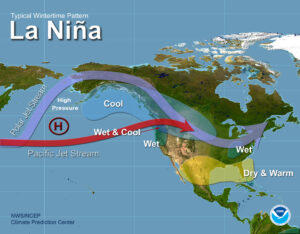Physical Address
23,24,25 & 26, 2nd Floor, Software Technology Park India, Opp: Garware Stadium,MIDC, Chikalthana, Aurangabad, Maharashtra – 431001 India
Physical Address
23,24,25 & 26, 2nd Floor, Software Technology Park India, Opp: Garware Stadium,MIDC, Chikalthana, Aurangabad, Maharashtra – 431001 India

By Aayushi Sharma
El Niño and La Niña events typically occur every two to seven years, although their occurrence is not strictly predictable. While El Niño events generally happen more frequently than La Niña events, the timing and intensity of each occurrence can vary widely. In the past few decades La Niña has changed its usual occurrence trend. To understand La Niña, it is important to understand the ENSO.
What is ENSO?
ENSO, the El Niño-Southern Oscillation, comprises a natural set of climate patterns characterized by interconnected sea surface temperatures and surface pressures in the tropical Pacific Ocean. These patterns encompass three phases: neutral, El Niño, and La Niña.
During the neutral phase, easterly trade winds prevail, leading to the upwelling of deep, relatively cool, nutrient-rich waters along the coast of Peru and the equator. Sea surface temperatures in the tropical Pacific remain within +/- 0.9°F of normal.
In an El Niño phase, the easterly trade winds weaken, causing a reduction in upwelling ocean currents along the coast of Peru and the equator. This weakening results in warmer than normal surface waters in the tropical Pacific.
Conversely, during a La Niña phase, the easterly trade winds strengthen, leading to intensified upwelling of cold ocean currents along the equator and the coast of Peru. This strengthened upwelling keeps warm surface waters in the western Pacific, leading to cooler than normal surface waters in the tropical Pacific overall.
Regions of La Niña and El Niño
El Niño is characterized by warmer than average sea surface temperatures in the central and eastern Pacific Ocean, while La Niña is marked by cooler than average sea surface temperatures in the same region. These phenomena can have significant impacts on global weather patterns, influencing temperature, rainfall, and atmospheric circulation patterns around the world. Despite their irregular schedule, monitoring and understanding El Niño and La Niña events are crucial for forecasting and mitigating their potential socioeconomic and environmental impacts.
Origin of names La Niña and El Niño
El Niño was initially identified by fishermen along the South American coast who observed unusually warm water in the Pacific Ocean, typically occurring around the start of the year. The term “El Niño” translates to “The Little Boy” or “Christ child” in Spanish, reflecting its tendency to coincide with Christmas. Conversely, La Niña, meaning “The Little Girl” in Spanish, refers to the opposite phenomenon characterized by cooler than average sea surface temperatures in the Pacific Ocean. La Niña is sometimes referred to as “an ENSO cold event,” highlighting its association with the broader El Niño-Southern Oscillation (ENSO) climate pattern.
Impact of La Niña on global climate
In the United States, winter temperatures exhibit distinct patterns during El Niño and La Niña events. During El Niño years, temperatures in the North Central States tend to be warmer than normal, while the Southeast and Southwest experience cooler than normal temperatures.
Conversely, during La Niña years, the Southeast tends to experience warmer than normal temperatures, while the Northwest tends to be cooler than normal. La Niña leads to higher-than-average sea-surface temperatures in the southern Pacific Ocean near northern Australia, New Guinea, and the Indonesian islands. Conversely, cooler sea-surface temperatures associated with La Niña occur in the southern Pacific Ocean off the coast of South America.
These regional temperature anomalies reflect the broader impacts of El Niño and La Niña on global climate patterns. In the tropics, ocean temperature variations during La Niña are typically opposite to those of El Niño, leading to contrasting weather patterns. While El Niño and La Niña are among several factors influencing climate at higher latitudes, their effects are most pronounced during wintertime. This information is crucial for weather forecasting and understanding the broader impacts of climate variability.
Carbon emissions from human activities have contributed to a sustained increase in global temperatures over time. While natural factors, such as the year-to-year status of the El Niño/Southern Oscillation (ENSO), can temporarily influence global temperatures, they generally fluctuate around this long-term warming trend caused by human activities.
Despite the cooling influence of the persistent La Niña phenomenon, 2022 still marked the sixth warmest year globally. Notably, regionally, 2022 ranked as the second warmest year on record for both Asia and Europe.
Both 2021 and 2022, characterized by consecutive La Niña events, rank among the top 10 hottest years on record. This trend, with all of the hottest years occurring since 2010, suggests that the brief cooling effect of La Niña has not been sufficient to offset the ongoing warming driven by human-induced climate change.
The altered occurrence trend of La Niña
According to a Sydney based weather channel, “Up until the 1997-1998 El Niño there was more often El Niño conditions and less often La Niña conditions, but from then onwards there has been more often La Niña conditions and less often El Niño conditions.”
According to a study, “The increased occurrence of double and triple La Niña events in recent times despite progress in El Niño/Southern Oscillation (ENSO) studies presents a puzzling phenomenon. While advancements in ENSO research have improved our understanding of the phenomenon, the exact reasons behind the clustering of multiyear La Niña events remain unclear. Possible factors contributing to this trend could include complex interactions between oceanic and atmospheric circulation patterns, changes in global climate dynamics, and natural variability within the climate system. Continued research and monitoring efforts are essential to unraveling the mechanisms driving these patterns and their implications for weather and climate variability on regional and global scales.”
References:
https://www.nature.com/articles/s41558-023-01801-6
https://www.climatecentral.org/climate-matters/local-and-global-effects-of-el-nino-and-la-nina-2023
Images:
https://www.pmel.noaa.gov/elnino/what-is-la-nina
Comments are closed.
[…] Climate Fact Checks has done detailed explainers on the phenomena which you can read here: El Niño and La Niña. […]